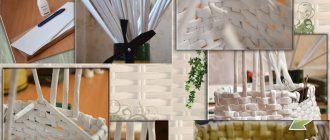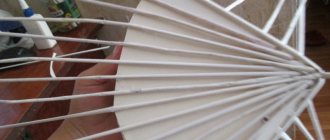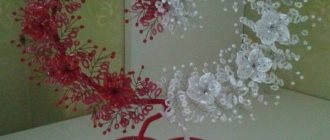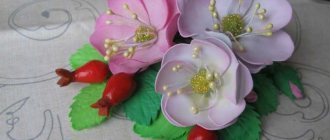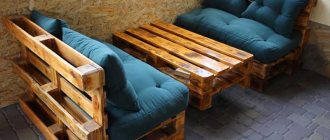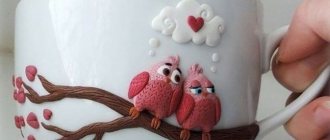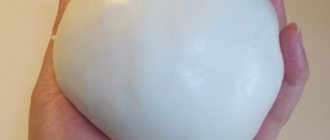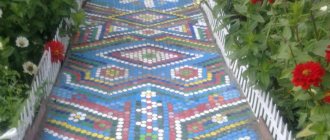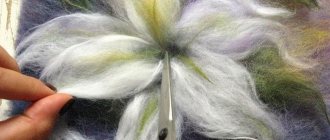What you will need
DIY crafts from newspaper tubes require a competent approach to choosing the material you will be dealing with. The lighter the paper, the better, as it is easier to weave with. Give your preference to unnecessary newspapers and non-glossy magazines.
We will also need:
- A sharp stationery knife with which we will obtain strips of paper.
- Using scissors we will trim the ends of the weave.
- A knitting needle onto which strips of newspaper are wrapped; the thinner it is, the better. Wooden or metal will do, as long as it is long.
- A short wooden stick, such as a skewer, to help thread the ends of the weave through each other.
- Two types of glue: PVA for preparing the material from which we will weave and “Moment” for more complex connections in a finished structure.
- The form in which you will paint (if necessary) your tubes. There can be one or several containers.
Baskets, boxes, boxes woven from newspapers: photos
Look through photos of finished products made from newspaper tubes to get some inspiration for creating your own craft. If you are new to this business, do not rush to immediately grab a large piece of work, a basket, for example, start with a small box.
Tray made from newspaper tubes Crafts from newspaper tubes Decorative flowerpot Easter crafts from newspaper tubes
Making straws
Next, we begin making the tubes, for which we take half a newspaper spread and, using a black marker, measure out the divisions at a distance of ten centimeters from each other. Using a knife or scissors, cut into strips and take one sheet and set the rest aside for now.
Looking at the photo of crafts made from newspaper tubes, you may not immediately notice, but a tighter twist is used for the base. To achieve this, place the knitting needle on the corner of the strip and start winding the paper at an angle of 45 degrees.
If you need a thinner tube, increase the angle to 60 degrees. When finished, coat the end of the paper with PVA glue, press and remove the knitting needle.
Making tubes from newspapers
By carefully familiarizing yourself with the technology of producing tubes for weaving, you can avoid making frequent mistakes that are typical for novice craftsmen. The most important stage in the production of products from paper tubes is the production of the blanks themselves. The decorative and operational characteristics of the finished product largely depend on their quality.
Before starting work, you need to prepare the main material - newspapers, as well as glue (PVA or pencil), scissors and a skewer (knitting needle) for twisting. The raw material for the manufacture of structures can be any paper: newspaper, magazine, office, fax. Many people like to use catalogs distributed in online stores.
Step 1. Newspaper sheets are cut into blanks having a width of 40...60 mm. Larger strip sizes may be required. It all depends on the diameter of the knitting needle and the thickness of the paper.
Cutting the newspaper
Step 2. Take a thin knitting needle (its diameter determines the size of the tubes).
Important! The thinner the knitting needle, the more difficult it is to make tubes, but over time you can get used to the size. The most convenient tool is considered to be one with a diameter of 1.5 mm. Often the size depends on the type of product being made. For structures such as a laundry basket, it is recommended to use knitting needles with a diameter of 2 mm. But the strips of paper should be wider - about 100 mm. Tubes obtained by twisting onto small-diameter knitting needles are less hollow, more difficult to wrinkle and hold volume better.
Step 3. The knitting needle is placed at an angle on a strip of paper. Moreover, the smaller the angle between it and the strip, the longer the tube can be made. There is no need to apply glue to this edge. Sometimes it happens that when you remove a knitting needle, the right end unwinds a little. But with certain experience this should not happen.
Let's start rolling up the newspaper
Step 4. The paper strip is gradually twisted onto the knitting needle. It is recommended to ensure that the strip fits as tightly as possible.
Using rotational movements, twist the tube, holding the edge
Curling process
Step 5. The remaining triangular tip of the newspaper must be treated with glue. After this, the tube is wrapped to the end.
Important! If you are using white consumer paper, a glue stick will not work. In this case, it is recommended to use PVA.
Step 6. After the operation is completed, the wire is removed from the tube. The result was a blank for future weaving.
Tubes are the working material needed for weaving
You can twist the strips either away from you or in the opposite direction. For right-handed people, the main working hand will be the right hand, the left hand will only move to the end of the tube as it is twisted and hold the product, helping to shape it. The spoke can be placed on top of the workpiece or below. Everyone chooses the most convenient option for themselves, which does not lead to painful sensations (fingers can hurt when producing a large number of workpieces) and allows the work to be done as quickly as possible.
Important! It’s easier to make blanks without lifting them from the table. Weightlifting will quickly lead to fatigue.
The result of your efforts will be blanks from which you can make a lot of useful things. Such tubes will perfectly replace the usual vine.
This is what newspaper tubes look like
Let's get started
There are a number of techniques that you need to know, since each of them allows you to achieve a unique and inimitable result for your work. Considering these techniques in isolation from practice will not give you anything. Therefore, we suggest moving from simple products to more complex ones, learning the basics of weaving.
forest owl
For the owl, you need to prepare five dark tubes and two of any other color in advance.
- Form small spirals of a centimeter in length from two light tubes and, without cutting them, glue them to the base - the eyes are ready.
- Place the spirals next to each other so that the base of each of them is in different directions from each other.
- Bend one dark tube slightly into a semicircle and place it above your eyes, then take a second strip and glue its ends to the middle. You should get a kind of figure eight. Place it above the owl's head, next to the existing blanks.
- Slide another one under all the tubes so that its middle is located directly under the eyes and begin to wrap around each side. As a result, you should get wings, so make a couple of turns around them, do not do this anymore, concentrating only on the body.
- If desired, the owl can be decorated with a nose and slightly fluffed tassels in the head area.
Identical developments
In this way, a colossal number of real masterpieces can be made. An example of this is the presentation of the topic: “Making woven napkins” at a labor lesson in the 4th grade.
In addition to achieving the goal (completing a task using a specific method), children consolidate previously acquired graphic skills, the ability to interact with a similar ingredient, develop accuracy, and creative imagination. Learn the cultural heritage and traditions of their ancestors.
Many beginning needlewomen are interested in how to make satin weaving and how satin weaving differs from it. This topic is studied in schools during labor lessons, specialized educational institutions, and universities.
Satin weave is the basic beginning of creativity and is accessible to almost every student. Such connections from papyrus matter form interesting patterns - these can be rhombuses, squares and other geometric shapes.
Obtaining such a canvas depends on the single overlaps and their location. In satin weaving, the most evenly laid single thread is observed. To create a satin paper twist, prepare two-color plates of different widths.
This is required to imitate weft and warp threads. In this matter, attentiveness, patience, accuracy are very important, but the main thing is to be able to correctly count the alternation of strips of thread. This knowledge is consolidated in labor lessons in the 5th grade, doing paper weaving using weaving technology.
Weaving from paper is clear proof that, having a great desire to create, it is quite easy to realize your desires by providing masterpieces made from ordinary newspaper.
Photo frame
Crafts from newspaper tubes or a master class from them allow you to make not only various kinds of animals, but also something useful for your home, for example, a photo frame. For it you will need a dense rectangular base on which you need to glue a sheet of newsprint. When everything is dry, take the blanks and apply glue along the edge to form the sides.
Start placing newspaper tubes in each corner at a forty-five degree angle. Their number will depend on the size of the photograph or painting that you place in the frame.
When you're done with the corners, start forming the inner sides. Glue only the corners, leaving the sides free to pass through. The frame can also be decorated with various patterns to suit your taste.
Weaving from newspapers: complex bending
A complex fold will definitely decorate baskets and boxes, boxes and vases woven from newspaper tubes. Weaving it is much more difficult, since it requires exact adherence to the pattern.
Complex bending: diagram Complex bending: weaving Complex bending: step-by-step work
Second bottom option
In the second case, we place an odd number of paired guides on the table and begin to braid them with two tubes, one of which is threaded from above, and the second from below.
Having reached the end, the tube is bent, and then the following guides are inserted into the edges. When inserting the guides, help yourself with scissors by cutting one of its ends.
Unusual types of “knitting”
- In the formation of the main links of products, a simple type is most often used, accessible to novice lovers of unique handicrafts.
- The layer-by-layer knitting method gives the manufactured items strength. They are devoid of gaps in the panel.
- To weave in rows, you need to use three “straws” alternately and simultaneously.
- Square weave allows you to create a checkered pattern.
- Rope is a method that helps strengthen the edges of the sides of a creation both at the top and bottom, making its bottom a solid and solid object.
- Openwork has an impressive range of varieties. All sorts of schemes are successfully used when creating the intended image.
Weaving walls
Two tubes are inserted into the base of the basket and braided around the posts - one goes in the front and the other in the back. Cut the part you will be inserting diagonally to continue weaving.
Press the inner paper vine with your fingernail to help it bend better. Continue this until the basket reaches the required height. If necessary, increase the guides by extending them with additional tubes.
Round basket with handle
Weaving from newspaper tubes, namely crafts from them, can turn out better if you use a frame. Such a frame can be a round plate on which the bottom or the entire work will be formed.
Take eight guide posts and connect them together, intertwining them with each other. They should form a square and face perpendicular directions. Next, take two tubes and insert them into the resulting base and begin to weave in a circle, forming the bottom and moving down.
The handle is made of woven paper vine, on which several tubes are wound.
Simple folding of the edge when weaving from newspapers: diagram, photo
Simple folding is an easy way to weave items from newspaper tubes. Any beginner in this business will master this weaving. Weaving is based on bending twigs intertwined with each other in one direction (see diagram).
Simple bend: diagram
Step-by-step weaving: simple bend

